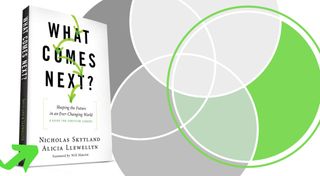
Books about leadership have a bad tendency to be dense; dry and hard work to read, and that’s before you get to the unobtainable objectives such as like read a book before you’ve lifted your head from the pillow in the morning. Maybe I’ve been reading the wrong books… but I’ve tended to stay away from this section of the library.
So, when your friends, Nick and Ali, write a book called What Comes Next?, kindly have their publishers ship it to you over the Christmas holiday, then tell you it’s a leadership book I have to confess that I approached reading it with a little bit of trepidation.
First off, this book feels approachable - it’s not a weighty tome, it comes in under 200 pages, had a pleasing shade of green running throughout the headings of the text, and while there are no pictures, it has really well designed set of graphics and Venn diagrams to help the visual learner get their head around core concepts of the text.
With a sub-200 page count, this book obviously isn’t going to cover everything there is to know about leadership. Instead Ali and Nick set their their focus on what is looks like to lead well when the context of your work changes on a regular basis the central question of the book - how can leaders prepare for an uncertain future?
This is where their main concept of futures thinking comes in. “The future is plural” they write:
"…the future rarely emerges predictably… it’s tempting to try and anticipate one ‘correct’ future, thinking about the future isn’t about being able to define what’s going to happen precisely. There isn’t just one possible future. Therefore, when contemplating what’s next, it’s appropriate to think in terms of ‘futures’.
The framework that What Comes Next? presents takes you through eight different areas that happen at the the intersection of purpose, people, place, and technology. These different areas are all areas that change, and end up influencing the decisions that we have to make. And in each area, a set a questions is posed to help you think through the topic both personally and with a team.
The thing in this book that most stands out to me is how approachable and relatable it is. While Nick and Ali ask you to face into some tough questions (and make notes on it!), the focus of on relationship throughout this book is unmissable, whether that is as the explore purpose and how we identify ourselves, and with that our duties and obligations to people, through to the chapter specifically about how we relate to one another, relationship is core:
“…Without knowing who you are and recognising your need to live in relationship, your work is futile. You are a ship aimlessly sailing in a vast ocean.”
When so many books in this space paint the picture of the visionary leader who either goes it alone, or walks over or through people to get there, this comes as a refreshing read.
While the book’s subtitle ‘A Guide for Christian Leaders’ implies that it is aimed at church leaders, a better take of it would be ‘A Guide for Christians in Leadership’ - this book helps frame how Christian faith helps leaders to set a direction and lead well towards it, in the church yes, but also in secular work, and in volunteer or side projects. Even those who do not have Christian faith will find many of the ideas outlined in the book helpful to think through.
While the book is short and easy to read, it’s not one to rush. There is a lot to consider and think through. Over the next few months I’m looking forward to working through the framework both at a personal level, and also exploring how I can outwork it within church and Kingdom Code.
You can find out more about the book, and buy a copy, from their website futuresframework.com, and there is also a podcast series that is accompanying the launch of the book.
Post changelog
- 2022-01-19 – Poke some more tags
- 2022-01-13 – Tidy up a number of blog posts for tags
- 2021-01-24 – Update posts with theme colours
- 2021-01-07 – What Comes Next?
